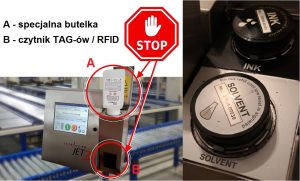ATTENTION! BLOCKADE

That is, how INK-JET printer manufacturers try to prevent you from buying consumables from other suppliers.
If we reach back into the not-so-distant past and look at the printers that were sold 10 - 15 years ago, we discover that most of them had no 'lock-in' on consumables. This meant that customers were able to buy chemistry from whichever supplier gave them the high quality of their products and a better price.
However, all good things come to an end quickly. Printer manufacturers eventually realised that the market mechanism was working ruthlessly against them, so in order to keep their profits from consumables sales for themselves, they started to think about how to prevent customers from buying chemistry from other suppliers.
IMPORTANT: Printer interlocks are the first indication that there are companies on the market that can supply you with consumables. If consumables could not be bought anywhere else, no one would be fitting any interlocks.
In this post I will show how the development of interlocks has evolved, using Leibinger's continuous ink-jet printers as an example. I believe that users of other printers such as: Videojet, Hitachi, Domino, Linx, Wiedenbach, Zanasi or Koenig & Bauer (KBA-Metronic) will see a clear parallel.

Leibinger JET3 + special bottle + TAG reader / RFID + consumables compartment (solvent / ink)
Pictured above is the Leibinger JET3 printer with the consumables compartment visible on the right. The JET3 is the company's flagship model, which is currently sold in various variants: JET3-UP, JET3-UP Pi, JET3-UP Mi, JET3-UP Pro, JET3-UP Rapid, JET3-UP Ep etc.
The first thing Leibinger did, in order to keep the profits from the chemistry trade for itself, was to use a bottle with a special thread width (fi 45mm, triple thread), which is screwed into the consumables compartment -. Point A. In this way, the solvent (or ink) flows into the reservoir when the platina placed under the cap is cut. In all earlier Leibinger models such as: JET2, JET2se, ECOJet you simply had to remove the cap from the actual tank and pour in the solvent or ink.
And that's it.
In theory, the use of such a bottle was supposed to prevent the refilling of consumables. However, the idea proved completely ineffective, as customers quickly found a workaround to this 'problem'. How? There are several ways:
1. After unscrewing the solvent and/or ink reservoir cap, simply unscrew the plate restricting access to the reservoir and add solvent/ink.
2. You can remove the solvent and ink tanks from the printer and cut holes in them. However, this method only applies to customers who do the maintenance themselves.
3. However, the simplest and most obvious way is No. 3, which one Leibinger printer user from the Silesian region told me about: "All you need is one dedicated bottle of solvent. You need to cut the bottom off in it, so that when you turn it over and screw it into the consumables compartment it will serve as a funnel. Then when the printer cries out for solvent you pour in the exact chemistry you used before." No comment.
Since the "special bottle" did not work as expected, it was decided at Leibinger to go into electronic interlocking (RFID technology). From then on, the replenishment of consumables was to look like this: when the solvent (or ink) ran out, a special TAG reader on the front of the printer - the Point B - apply a bottle of solvent (or ink), it is scanned and only then can it be refilled.
If you don't do a scan, but still top up the chemistry, the printer won't 'see' it anyway. The scanning process for the standard solvent 77001-00030 / SSN 1830 is demonstrated in the video below:
The idea was introduced evenly 10 years ago and in the initial phase it worked. However, the use of interlocks, in this case a special bottle and a TAG (RFID) reader, is a cost for the manufacturer. A cost that someone has to bear. In this case, 'someone' is - how else - the user of the printer.
The introduction of these interlocks led to Leibinger chemistry being at one point the most expensive chemistry on the market (and is still expensive - author's note). Because of this, the sales dynamics of the printers were decreasing and this was the case until other printer manufacturers started to introduce their blockers and thus the price level of consumables started to even out.
IMPORTANT: If you do not want to overpay for consumables then only choose printers from the manufacturer's range that do not have interlocks.
As with the bottles, solutions have emerged to enable owners of Leibinger printers to 'work around' the TAG (RFID) reader problem.
What are the solutions?
Feel free to get in touch! Write to biuro@mmtech.com.pl and handel@mmtech.com.pl or call
at +48 61 307 83 20. Let's talk about the details!
Date added: 27 September 2021.
Author of entry: Andrew

Comments are closed.